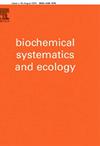银杏(银杏科)的植物化学研究及其化学分类学意义
IF 1.4
4区 生物学
Q4 BIOCHEMISTRY & MOLECULAR BIOLOGY
引用次数: 0
摘要
通过对银杏叶进行植物化学研究,分离并纯化了十六种化合物,其中包括一种双叶苷(1)、一种银杏内酯(2)、一种二肽(3)、五种木脂素(4-8)、两种黄酮类化合物(9、10)、两种甾醇(11、12)、三种酚类化合物(13-15)和一种脂肪醇(16)。通过核磁共振光谱和与文献数据的比较,对这些化合物的结构进行了表征。此外,还从化学分类学的角度讨论了这些化合物的重要性。本文章由计算机程序翻译,如有差异,请以英文原文为准。
Phytochemical investigation on Ginkgo biloba L. (Ginkgoaceae) and its chemotaxonomic significance
A phytochemical study conducted on Ginkgo biloba L. led to the isolation and purification of sixteen compounds which include one bilobalide (1), one ginkgolide (2), one dipeptide (3), five lignans (4–8), two flavonoids (9, 10), two sterols (11, 12), three phenolic compounds (13–15), and one fatty alcohol (16). Their structures were characterized by NMR spectroscopy and comparison with literature data. Among them, compounds (3–10, 12, 13, 15, 16) were isolated for the first time from Gingko biloba L. In addition, the importance of these compounds from a chemotaxonomic perspective was discussed.
求助全文
通过发布文献求助,成功后即可免费获取论文全文。
去求助
来源期刊

Biochemical Systematics and Ecology
生物-进化生物学
CiteScore
3.00
自引率
12.50%
发文量
147
审稿时长
43 days
期刊介绍:
Biochemical Systematics and Ecology is devoted to the publication of original papers and reviews, both submitted and invited, in two subject areas: I) the application of biochemistry to problems relating to systematic biology of organisms (biochemical systematics); II) the role of biochemistry in interactions between organisms or between an organism and its environment (biochemical ecology).
In the Biochemical Systematics subject area, comparative studies of the distribution of (secondary) metabolites within a wider taxon (e.g. genus or family) are welcome. Comparative studies, encompassing multiple accessions of each of the taxa within their distribution are particularly encouraged. Welcome are also studies combining classical chemosystematic studies (such as comparative HPLC-MS or GC-MS investigations) with (macro-) molecular phylogenetic studies. Studies that involve the comparative use of compounds to help differentiate among species such as adulterants or substitutes that illustrate the applied use of chemosystematics are welcome. In contrast, studies solely employing macromolecular phylogenetic techniques (gene sequences, RAPD studies etc.) will be considered out of scope. Discouraged are manuscripts that report known or new compounds from a single source taxon without addressing a systematic hypothesis. Also considered out of scope are studies using outdated and hard to reproduce macromolecular techniques such as RAPDs in combination with standard chemosystematic techniques such as GC-FID and GC-MS.
 求助内容:
求助内容: 应助结果提醒方式:
应助结果提醒方式:


